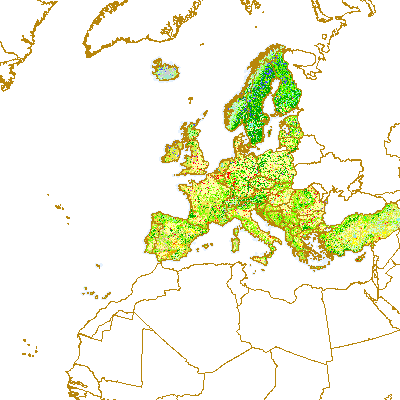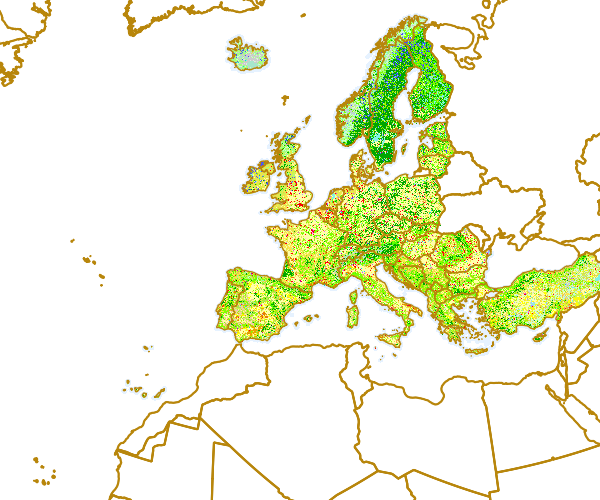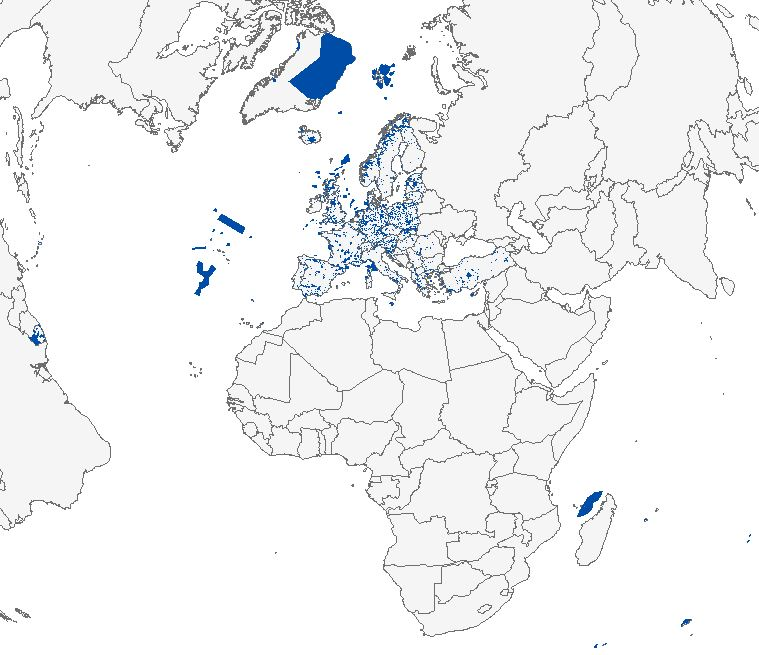SQLite
Type of resources
Available actions
Topics
INSPIRE themes
Keywords
Contact for the resource
Provided by
Years
Formats
Representation types
Update frequencies
status
Scale
-

CLC00 is one of the datasets produced within the frame the Corine Land Cover programme referring to land cover / land use status of year 2000. The Corine Land Cover (CLC) is an European programme, coordinated by the European Environment Agency (EEA), providing consistent information on land cover and land cover changes across Europe. CLC products are based on the photointerpretation of satellite images by the national teams of the participating countries - the EEA member or cooperating countries. The resulting national land cover inventories are further integrated into a seamless land cover map of Europe. The resulting European database is based on standard methodology and nomenclature with following base parameters: - 44 classes in the hierarchical 3-level Corine nomenclature - minimum mapping unit (MMU) for status layers is 25 hectares - minimum width of linear elements is 100 metres - minimum mapping unit (MMU) for Land Cover Changes (LCC) for change layers is 5 hectares CLC programme provides important data sets supporting the implementation of key priority areas of the Environment Action Programmes of the European Community as protecting ecosystems, halting the loss of biological diversity, tracking the impacts of climate change, assessing developments in agriculture and implementing the EU Water Framework Directive etc.. CLC programme is also a part of the Global Monitoring for Environment and Security (GMES http://gmes.info) initiative, run by the European Commission and the European Space Agency, which will provide environmental information from a combination of air- and space-based observation systems and in-situ monitoring. More about the Corine Land Cover (CLC) programme and datasets can be found at http://www.eea.eu.
-

CLC00_revised is one of the datasets produced within the frame the Corine Land Cover programme referring to land cover / land use status of year 2000. The Corine Land Cover (CLC) is an European programme, coordinated by the European Environment Agency (EEA), providing consistent information on land cover and land cover changes across Europe. CLC products are based on the photointerpretation of satellite images by the national teams of the participating countries - the EEA member or cooperating countries. The resulting national land cover inventories are further integrated into a seamless land cover map of Europe. The resulting European database is based on standard methodology and nomenclature with following base parameters: - 44 classes in the hierarchical 3-level Corine nomenclature - minimum mapping unit (MMU) for status layers is 25 hectares - minimum width of linear elements is 100 metres - minimum mapping unit (MMU) for Land Cover Changes (LCC) for change layers is 5 hectares CLC programme provides important data sets supporting the implementation of key priority areas of the Environment Action Programmes of the European Community as protecting ecosystems, halting the loss of biological diversity, tracking the impacts of climate change, assessing developments in agriculture and implementing the EU Water Framework Directive etc.. CLC programme is also a part of the Global Monitoring for Environment and Security (GMES http://gmes.info) initiative, run by the European Commission and the European Space Agency, which will provide environmental information from a combination of air- and space-based observation systems and in-situ monitoring. More about the Corine Land Cover (CLC) programme and datasets can be found at http://www.eea.eu.
-

CLC06 is one of the datasets produced within the frame the Corine Land Cover programme referring to land cover / land use status of year 2006. The Corine Land Cover (CLC) is an European programme, coordinated by the European Environment Agency (EEA), providing consistent information on land cover and land cover changes across Europe. CLC products are based on the photointerpretation of satellite images by the national teams of the participating countries - the EEA member or cooperating countries. The resulting national land cover inventories are further integrated into a seamless land cover map of Europe. The resulting European database is based on standard methodology and nomenclature with following base parameters: - 44 classes in the hierarchical 3-level Corine nomenclature - minimum mapping unit (MMU) for status layers is 25 hectares - minimum width of linear elements is 100 metres - minimum mapping unit (MMU) for Land Cover Changes (LCC) for change layers is 5 hectares CLC programme provides important data sets supporting the implementation of key priority areas of the Environment Action Programmes of the European Community as protecting ecosystems, halting the loss of biological diversity, tracking the impacts of climate change, assessing developments in agriculture and implementing the EU Water Framework Directive etc.. CLC programme is also a part of the Global Monitoring for Environment and Security (GMES http://gmes.info) initiative, run by the European Commission and the European Space Agency, which will provide environmental information from a combination of air- and space-based observation systems and in-situ monitoring. More about the Corine Land Cover (CLC) programme and datasets can be found at http://www.eea.europa.eu
-

Gridded Distribution of Species as reported during the Article 12 of the Birds Directive (2009/147/EC) covering the period 2008 to 2012. The data covers the EU 27 (2007). The dataset contains a support version of tabular data as reported by Member States, targeted for the assessment of bird population status at the European level for the 2008-2012 reporting period. This includes population sizes and trends (short and long term) for breeding and wintering populations, as well as pressures and threats for Special Protection Area trigger species. This version includes species flagged as sensitive by Member States. Information on the data quality of the 2008-2012 reporting round is available at http://bd.eionet.europa.eu/article12.
-

CLC00 is one of the datasets produced within the frame the Corine Land Cover programme referring to land cover / land use status of year 2000. The Corine Land Cover (CLC) is an European programme, coordinated by the European Environment Agency (EEA), providing consistent information on land cover and land cover changes across Europe. CLC products are based on the photointerpretation of satellite images by the national teams of the participating countries - the EEA member or cooperating countries. The resulting national land cover inventories are further integrated into a seamless land cover map of Europe. The resulting European database is based on standard methodology and nomenclature with following base parameters: - 44 classes in the hierarchical 3-level Corine nomenclature - minimum mapping unit (MMU) for status layers is 25 hectares - minimum width of linear elements is 100 metres - minimum mapping unit (MMU) for Land Cover Changes (LCC) for change layers is 5 hectares CLC programme provides important data sets supporting the implementation of key priority areas of the Environment Action Programmes of the European Community as protecting ecosystems, halting the loss of biological diversity, tracking the impacts of climate change, assessing developments in agriculture and implementing the EU Water Framework Directive etc.. CLC programme is also a part of the Global Monitoring for Environment and Security (GMES http://gmes.info) initiative, run by the European Commission and the European Space Agency, which will provide environmental information from a combination of air- and space-based observation systems and in-situ monitoring. More about the Corine Land Cover (CLC) programme and datasets can be found at http://www.eea.europa.eu
-

CLC06 is one of the datasets produced within the frame the Corine Land Cover programme referring to land cover / land use status of year 2006. The Corine Land Cover (CLC) is an European programme, coordinated by the European Environment Agency (EEA), providing consistent information on land cover and land cover changes across Europe. CLC products are based on the photointerpretation of satellite images by the national teams of the participating countries - the EEA member or cooperating countries. The resulting national land cover inventories are further integrated into a seamless land cover map of Europe. The resulting European database is based on standard methodology and nomenclature with following base parameters: - 44 classes in the hierarchical 3-level Corine nomenclature - minimum mapping unit (MMU) for status layers is 25 hectares - minimum width of linear elements is 100 metres - minimum mapping unit (MMU) for Land Cover Changes (LCC) for change layers is 5 hectares CLC programme provides important data sets supporting the implementation of key priority areas of the Environment Action Programmes of the European Community as protecting ecosystems, halting the loss of biological diversity, tracking the impacts of climate change, assessing developments in agriculture and implementing the EU Water Framework Directive etc.. CLC programme is also a part of the Global Monitoring for Environment and Security (GMES http://gmes.info) initiative, run by the European Commission and the European Space Agency, which will provide environmental information from a combination of air- and space-based observation systems and in-situ monitoring. More about the Corine Land Cover (CLC) programme and datasets can be found at http://www.eea.eu.
-

CLC90 is one of the datasets produced within the frame the Corine Land Cover programme referring to land cover / land use status of year 1990. The Corine Land Cover (CLC) is an European programme, coordinated by the European Environment Agency (EEA), providing consistent information on land cover and land cover changes across Europe. CLC products are based on the photointerpretation of satellite images by the national teams of the participating countries - the EEA member or cooperating countries. The resulting national land cover inventories are further integrated into a seamless land cover map of Europe. The resulting European database is based on standard methodology and nomenclature with following base parameters: - 44 classes in the hierarchical 3-level Corine nomenclature - minimum mapping unit (MMU) for status layers is 25 hectares - minimum width of linear elements is 100 metres - minimum mapping unit (MMU) for Land Cover Changes (LCC) for change layers is 5 hectares CLC programme provides important data sets supporting the implementation of key priority areas of the Environment Action Programmes of the European Community as protecting ecosystems, halting the loss of biological diversity, tracking the impacts of climate change, assessing developments in agriculture and implementing the EU Water Framework Directive etc.. CLC programme is also a part of the Global Monitoring for Environment and Security (GMES http://gmes.info) initiative, run by the European Commission and the European Space Agency, which will provide environmental information from a combination of air- and space-based observation systems and in-situ monitoring. More about the Corine Land Cover (CLC) programme and datasets can be found at http://www.eea.eu.
-

CLC00_revised is one of the datasets produced within the frame the Corine Land Cover programme referring to land cover / land use status of year 2000. The Corine Land Cover (CLC) is an European programme, coordinated by the European Environment Agency (EEA), providing consistent information on land cover and land cover changes across Europe. CLC products are based on the photointerpretation of satellite images by the national teams of the participating countries - the EEA member or cooperating countries. The resulting national land cover inventories are further integrated into a seamless land cover map of Europe. The resulting European database is based on standard methodology and nomenclature with following base parameters: - 44 classes in the hierarchical 3-level Corine nomenclature - minimum mapping unit (MMU) for status layers is 25 hectares - minimum width of linear elements is 100 metres - minimum mapping unit (MMU) for Land Cover Changes (LCC) for change layers is 5 hectares CLC programme provides important data sets supporting the implementation of key priority areas of the Environment Action Programmes of the European Community as protecting ecosystems, halting the loss of biological diversity, tracking the impacts of climate change, assessing developments in agriculture and implementing the EU Water Framework Directive etc.. CLC programme is also a part of the Global Monitoring for Environment and Security (GMES http://gmes.info) initiative, run by the European Commission and the European Space Agency, which will provide environmental information from a combination of air- and space-based observation systems and in-situ monitoring. More about the Corine Land Cover (CLC) programme and datasets can be found at http://www.eea.eu.
-

The Common Database on Designated Areas (CDDA) is more commonly known as Nationally designated areas. The inventory began in 1995 under the CORINE programme of the European Commission. It is now one of the agreed Eionet priority data flows maintained by EEA with support from the European Topic Centre on Biological Diversity. It is a result of an annual data flow through Eionet countries. The EEA publishes the data set and makes it available to the World Database of Protected Areas (WDPA). The CDDA data can also be queried online in the European Nature Information System (EUNIS). Geographical coverage of GIS vector boundary data: Albania, Austria, Belgium, Bosnia and Herzegovina, Bulgaria, Croatia, Cyprus, Czech Republic, Denmark, Estonia, Finland, Great Britain, Greece, Ireland, France, Germany, Iceland, Italy, Kosovo under UNSC Resolution 1244/99, Latvia, Liechtenstein, Lithuania, the North Macedonia, the Netherlands, Norway, Poland, Portugal, Romania, Serbia, Slovakia, Slovenia, Spain, Sweden and Switzerland. EEA does not have permission to distribute some or all sites reported by Austria, Bulgaria, Estonia, Ireland, Romania and Turkey. When re-using the data, copyright is to be mentioned specifically for Estonia and for Finland: "Estonian Environmental Register 02.03.2015"; "©Finnish Environment Institute, 2015".
-

The Common Database on Designated Areas (CDDA) is more commonly known as Nationally designated areas. It is the official source of protected area information from European countries to the World Database of Protected Areas (WDPA). The inventory began in 1995 under the CORINE programme of the European Commission. It is now one of the agreed Eionet priority data flows maintained by EEA with support from the European Topic Centre on Biological Diversity. The CDDA data can be queried online in the European Nature Information System (EUNIS). Geographical coverage of GIS vector boundary data: Albania, Austria, Belgium, Bosnia and Herzegovina, Bulgaria, Croatia, Cyprus, Czech Republic, Denmark, Estonia, Finland, France, Germany, Greece, Hungary, Iceland, Ireland, Italy, Kosovo under UNSC Resolution 1244/99, Latvia, Liechtenstein, Lithuania, Luxembourg, the North Macedonia, Malta, Montenegro, the Netherlands, Norway, Poland, Portugal, Romania, Serbia, Slovakia, Slovenia, Spain, Sweden, Switzerland and United Kingdom. EEA does not have permission to distribute some or all sites reported by Estonia, Ireland, Romania and Turkey. When re-using the data, copyright is to be mentioned specifically for Estonia and for Finland: "Estonian Environmental Register 01.01.2017; "©Finnish Environment Institute, 2017".
 RUC Geo-Data catalogue
RUC Geo-Data catalogue